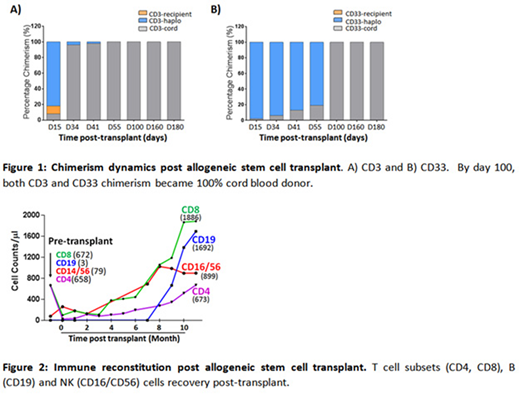Abstract

Background: Although current antiretroviral therapies have effectively changed the course of HIV-1 infection, it remains an incurable illness. The C-C chemokine receptor type 5 (CCR5) is the key co-receptor for HIV entry into CD4+ T cells. Homozygous 32 deletion (delta32) in CCR5 genes leads to resistance to HIV-1 infection 1. Allogeneic stem cell transplant from a donor with CCR5 delta32/32 mutation was curative for HIV in an HIV-1-infected man (Berlin Patient) with AML 2. It has been challenging to replicate this experience. We present our experience with a single case of successful engraftment of CD34-selected, related haploidentical peripheral blood and CCR5delta32 cord blood stem cell transplant (haplo-cord) in an HIV-1-infected woman who, like the Berlin patient, developed AML and is now doing well at almost one-year post transplantation.
Clinical case: A 60-year-old African-American woman was diagnosed with HIV-1- infection in June 2013 and was started on an antiretroviral treatment (ART) regimen consisting of tenofovir, emtricitabine and raltegravir. Her pre-ART viral load and CD4 counts were 1,000,000 copies/ml and 1003 cells/mm3, respectively. In Nov, 2013 she had viral load < 20 copies/ml with CD4 counts of 980 cells/mm3 and her HIV-1 infection was relatively asymptomatic. In March 2017, she was diagnosed with AML with monosomy 7. Her HIV therapy after the AML diagnosis was changed to abacavir- lamivudine -dolutegravir- combination. She achieved morphologic and cytogenetic remission after 1 cycle of standard idarubicin/cytarabine induction chemotherapy. In addition, she received 1 cycle of HiDAC consolidation and was referred for allogeneic stem cell transplant. We identified a CCR5 delta32/32 mutated cord blood unit (CBU) which was 5/8 HLA matched and contained 1.3 x 107 nucleated cells/kg and 3.2 x 104 CD34+ cells/kg.
She underwent a combined CD34-selected, haploidentical peripheral blood and CCR5delta32 cord blood stem cell transplant (haplo-cord) in August 2017. Her conditioning regimen was with fludarabine/melphalan/and TBI400 and she also received ATG/MMF/tacrolimus for GVHD prophylaxis. Her neutrophils and platelets engrafted on day 10 and 16, respectively and she was discharged on day +16 post-transplant. Her post-discharge hospital course was complicated by CMV reactivation (no organ involvement) 2 months post-transplant with peak viral level of 1374 copies/ml. She did not have evidence for EBV re-activation or graft-vs-host disease. Her plasma HIV viral load remained undetectable post- transplant while remaining on abacavir/lamivudine and dolutegravir-based ART.
Her day+180 bone marrow showed continued AML remission and she remains in clinical remission near one year post-transplant. CD3 chimerism showed 82% haploidentical donor and 8% CBU and 10% recipient on day +15 post-transplant (Figure 1). The chimerism composition switched to 96% CBU by day+34, and became and remained 100% CBU since day+55. CD33 chimerism showed 98% haploidentical donor and 2% cord donor on day+15 post-transplant. It was 81% haploidentical donor and 19% cord on day+55 and became 100% cord by day+100. She has continued CD4, CD8, NK and CD19 cell recovery, with normal T cell subsets currently (Figure 2). Her CD4 count dropped to 27 cells/mm3 at one-month post-transplant and currently is at 673cells/mm3. She is currently 11 months post-transplant and is back to her normal daily activities
Conclusion: Haplo-cord transplantation with CCR5 delta 32/32 CBU resulted in rapid engraftment and immune replacement with dominance of the CCR5 delta 32/32 CBU graft in an HIV-1-infected woman. Successful suppression of HIV-1-replication to clinically undetectable levels was maintained throughout the transplant period for up to one year. . Correlative viral and immunological studies are ongoing, along with effects on the latent reservoir, which was detectable pre-transplant. It is possible to identify appropriate CCR5 delta 32/32 CBU units for haplo-cord transplantation in HIV-1- infected patients with implications for HIV-1 cure.
No relevant conflicts of interest to declare.
Author notes
Asterisk with author names denotes non-ASH members.

This icon denotes a clinically relevant abstract


